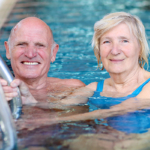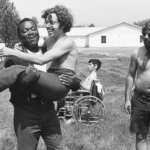New biomechanical footwear relieves knee OA pain
A new biomechanical footwear system was effective in relieving pain and improving physical function among patients with knee osteoarthritis, according to results of a randomized controlled trial presented at the ACR/ARHP 2018 Annual Meeting.
Stephanie Viguers, Healio November 4, 2018
“Biomechanics play an important role in knee OA and several biomechanical treatments for knee OA have emerged,” Stephan Reichenbach PhD, head of research at the Institute of Social and Preventive Medicine, University of Bern, Switzerland, said during a presentation. “The Cochrane Review of 2015 ruled that the evidence of their effectiveness is still inconclusive.”

NFL veterans show off their AposTherapy shoes. No Camels
The experimental biomechanical footwear system (AposTherapy) is a regular shoe with two adjustable convex pods that are screwed into the soles. The pods have different degrees of convexity and diameters that are designed to retrain neuromuscular control, improve functional alignment while walking and unload pressure from the affected areas, thereby reducing pain. Certified physical therapists individually calibrate the footwear system based on patients’ symptoms and observed gait pattern.
| AposTherapy is a clinically proven drug-free and non-surgical treatment for knee osteoarthritis, torn meniscus, knee ligament damage & lower back pain. Our treatment has already helped over 40,000 patients worldwide, watch the video to learn how. AposTherapyVideo. Youtube Nov 20, 2013 |
Previously, results of a small, non-randomized controlled trial showed that the biomechanical footwear system substantially improved pain among patients with knee OA. To further investigate, Reichenbach and colleagues conducted a randomized controlled trial comparing the efficacy of the footwear system with the sham device, which has flat pods.
The researchers randomly assigned 111 patients with knee OA to use the experimental footwear system and 109 patients to the sham device. At baseline, the average WOMAC pain score was 4.1.
The patients were instructed to use the footwear for 30 minutes per day during week 1, increasing its use by 10 minutes per day each week thereafter, reaching a maximum of 5 hours per day at week 24. Each patient’s footwear was recalibrated after weeks 4, 8, 12 and 16. However, because the sham device does not have adjustable pods, technicians pretended to make adjustments to these shoes.
By week 24, six patients assigned to the experimental footwear system and 13 assigned to the sham device discontinued use.
Overall, patients assigned to the experimental footwear system had greater reductions in pain (adjusted mean difference = 1.34; 95% CI, -1.78 to -0.91) and stiffness (adjusted mean difference = 1.41; 95% CI, -1.92 to -0.90) and a greater improvement in physical function (adjusted mean difference = 1.10; 95% CI, -1.49 to -0.70).
A 30% reduction in pain was reported by 92% of patients assigned to the experimental footwear system vs. 58% assigned to the sham device (adjusted risk difference of 34%; 95% CI, 23%-45%). Similarly, a 50% reduction was reported by 82% of patients in the experimental footwear group vs. 42% in the sham device group (adjusted risk difference of 41%; 95% CI, 28%-52%).
The safety profiles were similar, with 18 possibly treatment-related adverse events in the biomechanical footwear group and 17 possibly treatment-related adverse events in the sham footwear group. No serious treatment-related adverse events were reported.
“This trial suggests that the new biomechanical footwear system is both efficacious and safe in relieving knee pain and disability with knee OA,” Reichenbach concluded.
Source Healio
| References |
Biomechanical Therapy for Osteoarthritis of the Knee: A Randomized Controlled Trial, Stephan Reichenbach, Sarah Heldner, Armando Lenz, David T Felson and Peter Jüni. Abstract 957. Presented at: ACR/ARHP Annual Meeting, Oct. 20-24, 2018; Chicago.
LB0002 Biomechanical therapy for osteoarthritis of the knee: a randomised controlled trial (BIOTOK), S Reichenbach, S Heldner, A Lenz, D Felson, P Jüni. Annals of the Rheumatic Diseases 2018;77:82-83. PDF
APOS Therapy for Osteoarthritis of the Knee: a Randomized Controlled Trial BIOTOK,. University Hospital Inselspital, Berne. February 28, 2018. NIH NCT02363712
With a biomechanical treatment in knee osteoarthritis, less knee pain did not correlate with synovitis reduction, Swaminathan V, Parkes MJ, Callaghan MJ, O’Neill TW, Hodgson R, Gait AD, Felson DT. BMC Musculoskelet Disord. 2017 Aug 10;18(1):347. doi: 10.1186/s12891-017-1691-1. Full text
Also see
OA risk over 40 years predictable at age 18 years Healio
AposTherapy Shoes Are A Big Step Towards Ridding The World Of Chronic Knee And Back Pain NoCamels.com







